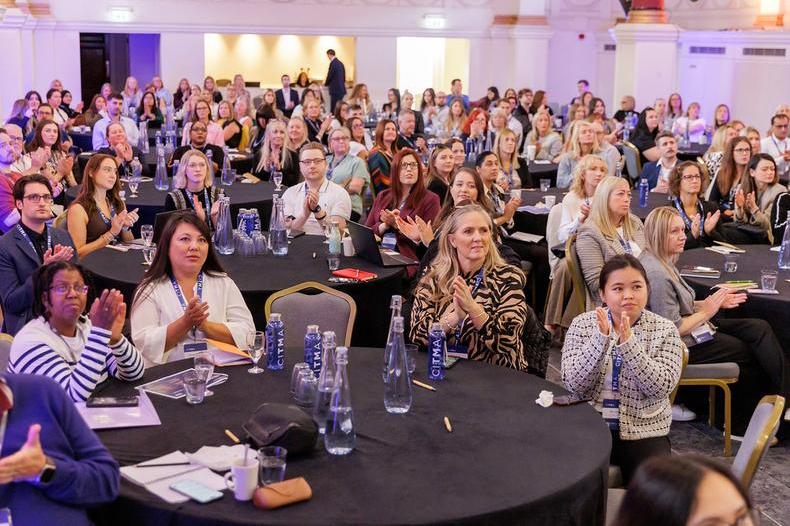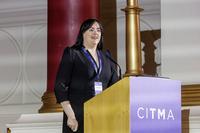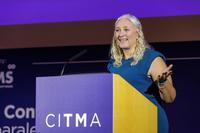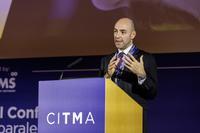CITMA Paralegal Conference 2025: Key talking points
This year's conference saw 170 paralegals, speakers and exhibitors packed into BMA House in London for a day of learning and building new connections.

Thank you to all our speakers and WebTMS for sponsoring the event. This article explores some of the key talking points from the day’s sessions.
What’s changed for lookalikes?

Kerri Ann Hazzard, a Chartered Trade Mark Attorney at Baker McKenzie, provided delegates with a look at recent cases, focusing on the latest developments on ‘dupes’ including Thatcher’s v Aldi and Iconix (Umbro) v Dream Pairs following UK Supreme Court cases.
The lookalikes landscape in the UK is changing, Kerry Ann told delegates. In recent cases there is a focus on the ‘context’ of infringement, and how this plays out in real life. Simple side-by-side comparisons alone may not be sufficient, Kerri Ann pointed out.
Thatchers v Aldi was a landmark case for lookalikes and there is some commentary that it shows the UK courts are clamping down on dupes and lookalikes, Kerry Ann said. But, “that is yet to be seen because these cases tend to be quite fact specific - but it does show that it is important that you register the overall packaging or the visual appearance of a product or that at least that's a conversation that you have with clients when they're considering their filing and enforcement strategy.”
Steps to avoid anti-money laundering

Amy Bell from Teal Compliance took delegates through anti-money laundering: what it is, how to spot it, and the steps you can take to avoid being drawn into a money laundering situation.
Amy started by explaining the risks if you get involved in money laundering, with a breakdown below:
| POCA | MLR |
|---|---|
| Up to 14 years in prison | Up to 2 years in prison |
| s.327 – Conceal, disguise, convert, transfer, or remove (from the UK) criminal property s.328 – Become concerned in an arrangement s.329 – Acquire, use, or have possession of criminal property |
Matter Based Risk Assessment Identification Verification Purpose and Nature On-going Monitoring |
| Up to 5 years in prison | |
| s.330/1/2 – Failure to disclose an offence |
In particular, Amy was keen to highlight s.328: ‘Becoming concerned in an arrangement facilitating acquisition, use, or possession of criminal property’ to delegates, saying, “You might be advising on IP aspects, ancillary to a transaction, and that's where you might get caught out. If you, as a result of what you've seen in that case, suspect that it's a front for money laundering, then if you don't report it, that is an offense.”
She moved on to discuss the different ways criminals might exploit IP and how delegates can protect themselves. This is where the Money Laundering Regulations (2017) comes in, forming part of a broader economic crime regime, which aims to prevent illicit funds from entering the legitimate financial system.
Amy added, “It forces you to ask questions through client due diligence so that if there are any suspicions, you'll spot them and you'll tell the police about it.
Fashion counterfeiting

Emma Day and Bea Marie Manlapaz, both trainee trade mark attorneys at Stobbs IP, discussed the vital role of paralegals in anti-counterfeiting within the fashion industry.
Paralegals serve as a key liaison point with customs authorities “ensuring that they have the right information and tools to act decisively against fake goods,” Bea Marie said.
“The battle against counterfeit goods is complex and continuous, but Paralegals are uniquely positioned to navigate and strengthen every critical step in anti-counterfeiting effort.”
She championed the role of paralegals, saying they are:
- Process champions
- Problem solving
- Project managers
They are best positioned to be brand guardians and can help keep everyone aligned and informed, Bea Marie said.
Emma discussed how paralegals lay the groundwork for strategic pre-emptive measures with portfolio management, online monitoring and recordals all featuring as important parts.
In-house vs private-practice perspectives

Next up was a panel discussion on in-house vs private practice with Louise Williams (in-house at Superdry Limited) and Carly Sherwood (private practice at Barker Brettell) both sharing their perspectives.
Their insights underscored how team size, business model, and firm culture shape everything from day-to-day responsibilities to professional growth opportunities.
Carly explained that in private practice, work is often driven by client type, sector breadth, and team structure, “Every client's different and many issues can crop up, so there's potential for more variety. That said, variety can depend on the attorney that you work for and the size of the brand portfolio.”
In contrast, Louise detailed how in-house roles can offer broader business exposure early on due to smaller legal teams, though added that trade mark work may be narrower in scope. She explained, “When I first started on the team four years ago, I was brand new to the IP industry and getting that exposure from day one; shadowing at meetings, working closely with my general counsel, attending meetings with the CEO, it’s very important.”
Both speakers emphasised the importance of building strong relationships, whether in-house or private practice, and how open and honest communication is central to their roles. For Carly, it’s a way of avoiding difficult situations further down the line, “It’s important to educate clients so they know that if similar issues crop up in the future that they come to you sooner.”
Reflecting on the session, it was noted how both sectors are equally challenging and rewarding, with no benefit outweighing one more than the other. Carly added, “I think it just goes to show that whether you're in private practice or in-house, we're all there to do a role and to achieve the same thing.”
How paralegals shape business development

Successful business development (BD) is a team game, Douglas McPherson from Potter Clarkson told delegates. He posed the question, is BD not just for fee earners? “No” was his response, “everyone in the team has a massively valuable contribution to make to BD efforts,” he said.
Paralegals know where improvements in operational excellence and service efficiency can be made. This can benefit everyone, he said.
Douglas also told our engaged audience that they can help improve fee earners’ client development by providing greater insight into clients’ portfolios, flagging issues and monitoring industry news.
Paralegals can support with marketing initiatives such as content creation, engaging with social media and sharing internal knowledge. They can also support building proposals.
Douglas reiterated the importance of extending the firm’s professional network through attending events.
Unusual trade marks

Mark Wilden, a commercial barrister at 3PB Chambers, discussed the many weird and wonderful trade mark attempts from the recent past, including smells, faces and jingles. Before delving into some of the examples, he first covered the core criteria for registering a trade mark.
(1) In this Act "trade mark" means any sign which is capable -
-
of being represented in the register in a manner which enables the registrar and other competent authorities and the public to determine the clear and precise subject matter of the protection afforded to the proprietor, and
-
of distinguishing goods or services of one undertaking from those of other undertakings.
A trade mark may, in particular, consist of words (including personal names), designs, letters, numerals, colours, sounds or the shape of goods or their packaging.
Mark then moved on to discuss real-world examples of registration attempts and the significant practical challenges in representing and enforcing such marks. He highlighted key issues like the need for precise, objective representation, the difficulty of searching and comparing these marks, and the fundamental question of whether they can truly denote the origin of goods and services.
Ultimately, Mark suggested that while technology and consumer behaviours are evolving, these unusual trade marks currently face substantial barriers. The registration process is complex, enforcement is challenging, and the practical utility of such marks remains limited.
However, he proposed that new technologies like AI might eventually help make these unconventional trade marks more viable, “In the case of sound marks, it's not difficult to consider an AI tool or some other device that could analyse sounds and auto-generate descriptions.”
One IPO update

Simeon Bowen from the UK IPO shared the latest developments on the most significant digital transformation in the UK IPO’s 170-year history.
The patents service is in its pilot phase currently with 90 firms and 400 individuals signed up to the patents service with 250 live transactions already made on the platform. It is due to launch in 2026, after which work on the trade marks service will begin.
The trade marks service will be built on the same platform as the patents service. Simeon outlined the five steps the UK IPO will take:
- Discovery – gathering feedback to understand what we have to build
- Alpha – building prototypes and early designs and testing them
- Build – building the new service
- Pilot – release the service to a small group of customers to test and get feedback
- Public launch – service is made available to all trade marks customers
On series marks, Simeon confirmed that they will cease when the trade marks service launches, but there is no set date yet.
Simeon reiterated the commitment to continuous improvement, and users will continue to see enhancements made after launch.
Key U.S. developments

Sahil Malhotra from Drishti Law wrapped up the day with the latest U.S. IP developments and what they mean for UK-based practice. The talk focused on three key changes, including:
- Deadlines
- Evidence
- Systems
The USPTO response deadlines have been shortened from six months to just three months for office actions, with only one paid extension available. Standards for specimens and audits have also been tightened, with all web page captures requiring a visible URL and access/print dates. Specimens for goods must show the mark with product, price, and purchase mechanism.
Sahil also informed delegates that new system requirements will affect access to USPTO filing platforms. Two-factor authentication, identity verification, and attorney sponsorship for support staff are now mandatory. He advised that everyone complete these processes to avoid filing delays.
View photo gallery
